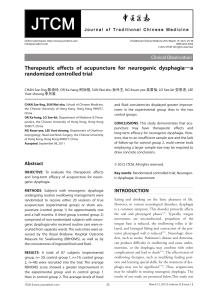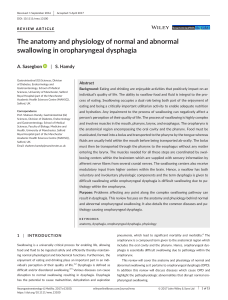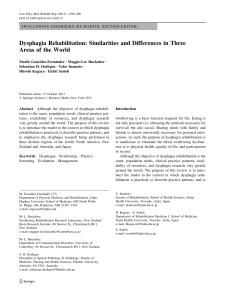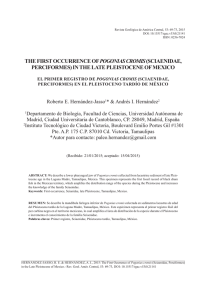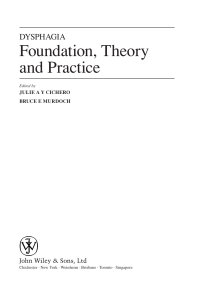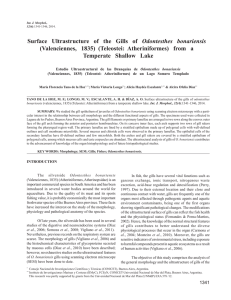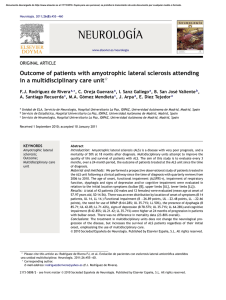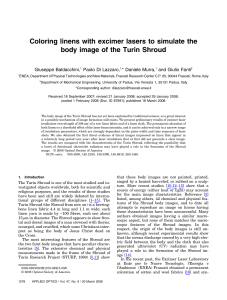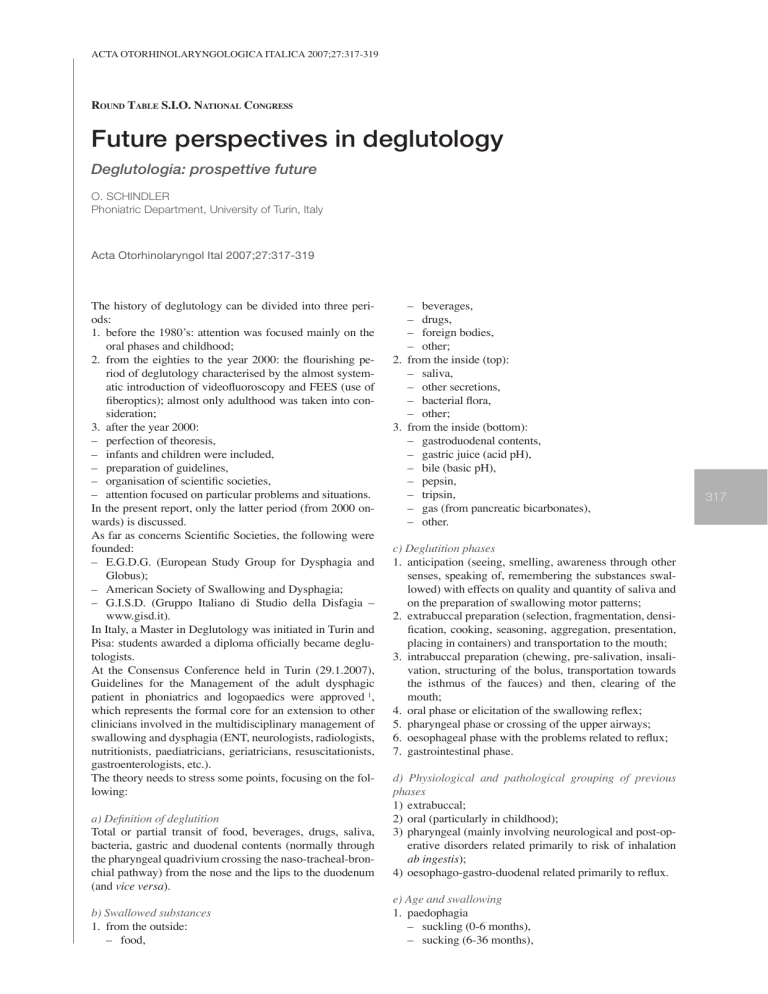
ACTA otorhinolaryngologica italica 2007;27:317-319 Round Table S.I.O. National Congress Future perspectives in deglutology Deglutologia: prospettive future O. Schindler Phoniatric Department, University of Turin, Italy Acta Otorhinolaryngol Ital 2007;27:317-319 The history of deglutology can be divided into three periods: 1. before the 1980’s: attention was focused mainly on the oral phases and childhood; 2. from the eighties to the year 2000: the flourishing period of deglutology characterised by the almost systematic introduction of videofluoroscopy and FEES (use of fiberoptics); almost only adulthood was taken into consideration; 3. after the year 2000: – perfection of theoresis, – infants and children were included, – preparation of guidelines, – organisation of scientific societies, – attention focused on particular problems and situations. In the present report, only the latter period (from 2000 onwards) is discussed. As far as concerns Scientific Societies, the following were founded: – E.G.D.G. (European Study Group for Dysphagia and Globus); – American Society of Swallowing and Dysphagia; – G.I.S.D. (Gruppo Italiano di Studio della Disfagia – www.gisd.it). In Italy, a Master in Deglutology was initiated in Turin and Pisa: students awarded a diploma officially became deglutologists. At the Consensus Conference held in Turin (29.1.2007), Guidelines for the Management of the adult dysphagic patient in phoniatrics and logopaedics were approved 1, which represents the formal core for an extension to other clinicians involved in the multidisciplinary management of swallowing and dysphagia (ENT, neurologists, radiologists, nutritionists, paediatricians, geriatricians, resuscitationists, gastroenterologists, etc.). The theory needs to stress some points, focusing on the following: a) Definition of deglutition Total or partial transit of food, beverages, drugs, saliva, bacteria, gastric and duodenal contents (normally through the pharyngeal quadrivium crossing the naso-tracheal-bronchial pathway) from the nose and the lips to the duodenum (and vice versa). b) Swallowed substances 1. from the outside: – food, – beverages, – drugs, – foreign bodies, – other; 2. from the inside (top): – saliva, – other secretions, – bacterial flora, – other; 3. from the inside (bottom): – gastroduodenal contents, – gastric juice (acid pH), – bile (basic pH), – pepsin, – tripsin, – gas (from pancreatic bicarbonates), – other. c) Deglutition phases 1. anticipation (seeing, smelling, awareness through other senses, speaking of, remembering the substances swallowed) with effects on quality and quantity of saliva and on the preparation of swallowing motor patterns; 2. extrabuccal preparation (selection, fragmentation, densification, cooking, seasoning, aggregation, presentation, placing in containers) and transportation to the mouth; 3. intrabuccal preparation (chewing, pre-salivation, insalivation, structuring of the bolus, transportation towards the isthmus of the fauces) and then, clearing of the mouth; 4. oral phase or elicitation of the swallowing reflex; 5. pharyngeal phase or crossing of the upper airways; 6. oesophageal phase with the problems related to reflux; 7. gastrointestinal phase. d) Physiological and pathological grouping of previous phases 1) extrabuccal; 2) oral (particularly in childhood); 3) pharyngeal (mainly involving neurological and post-operative disorders related primarily to risk of inhalation ab ingestis); 4) oesophago-gastro-duodenal related primarily to reflux. e) Age and swallowing 1. paedophagia – suckling (0-6 months), – sucking (6-36 months), 317 O. Schindler – i. transition-vertical chewing (3-7 years), – ii. transition-lateral and rotatory chewing (7-10 years); 2. adult deglutition; 3. presbiphagia or gerontophagia. f) Rheology of swallowed substances – fluids (with negative endo-oral pressure); – solids (with positive endo-oral pressure); – gas (almost unknown); – mixed. g) Nervous controls, processing and management – peripheral afference to bulbar nuclei (n. tractus solitarius); – afference from sovrabulbar structures (anterior and posterior cortex, mainly at insula, diencephalic, mesencephalic, pontocerebellar level) to bulbar nuclei; – efference from bulbar nuclei (n. ambiguus and n. motor trigeminal) to peripheral area. Among the particular problems and situations we consider: a) Pharmacological aspects, especially – drugs concerned within treatment of salivation (and equivalents of saliva); – anti-spastic (botulinus) and stimulators of swallowing or procinetic drugs; – anti-reflux drugs and proton pump inhibitor and other drugs acting at gastro-intestinal level. 318 b) Critical points of correlation – caloric intake and hydration; – nasogastric tubes and PEG; – tracheal tubes; – phonation; – general performances; – language and communication; – CNS structures and functions. c) Clinical situations – resuscitation; – neonatology (with special attention focused on non dysphagic prematurity); – residences for elderly and non independent subjects; – hygiene and “good swallowing”. One area we should like to further explore concerns swallowing in childhood or paedophagy. We shall consider separately oral swallowing deviances, to be intended almost always as absent, incomplete or a distorted acquisition of oral motor patterns with consequent dental malocclusions (and requiring orthodontic intervention), buccal trance, incorrect habits, phonetic-phonologic impairments, possibly affecting learning of reading and writing, etc. These problems present in different degrees in approximately 30% of the population aged between 4 and 7 years and have become almost autonomous also due to the frequent association, in logopaedic practice, with myofunctional theories and techniques. Another chapter which is not easy to distinguish from the former, and which can occur in any age in childhood (and not only) is (mainly oral) ex non usu dysphagia caused by the buccal immaturity or oral lack of or poor education. Independently of severe impairment of all the structures of swallowing (from the mouth to the diaphragm) or as a consequence of prolonged use of nasogastric tubes or PEG, or associated with severe impairment of general performances, conscience, behaviours, this disorder exists in every condition of buccal hyperprotection with administration of “easy foods”, not involving an important endo-oral preparation. In such cases which sometimes require years of education to reach at least a partial resolution, it should not be forgotten that: – in any case, oral intake of beverages and foods (of any kind and consistency) is always possible taking the right precautions and not necessarily by a retro-buccal swallowing; – giving “difficult” food requiring scrupulous oral preparation is often better than a series of logopaedic training sessions. A general overview of paedophagia in given in Table I. Table I. Taxonomy of paediatric dysphagia (modified from Rommel et al.) 2. Taxonomy of paediatric dysphagia In a study of 700 children with alimentary impairments (Rommel et al. 2003) the causes were: 1. Medical (established diagnosis) 2. Oral (functional oro-pharingeal/pharyngeal abnormality) 81.6% 61% 3. Behavioural (bad interaction mother/child, phobias, refuse) 18.1% 1+2 48.5% 2+3 1.5% 1+3 5.2% 1+2+3 5.9% Our cases observed over the last year are outlined in Table II. Table II. Cases observed, in 2006, at the Phoniatric Department of the University of Turin, Italy. No. patients = 83 (43 males, 40 females) Mean age 38.13 months (range 3-180) 45 of them had a triple evaluation: – clinical – flexible fiberoptics – videofluorography Age distribution is shown in Figure 1. Causes of paedophagic dysphagia are: – gastro-intestinal (oesophageal atresia, reflux …); – respiratory (choanal atresia, laryngeal malformations …); – neurological (cerebral palsy, anoxic, toxic, infectious encephalopathies, tumours, degenerations, malformations, syndromic …); – cardiac (interventricular defects …); Fig. 1. Age distribution of patients studied. Future perspectives in deglutology – craniofacial malformations (cleft palate, Moebius, Pierre Robin, plurimalformations); – prematurity; – hyperprotection (primary, secondary); – pathology ex non usu (no food exposure in the first months/years of life). Aetiological distribution of the cases studied can be found in Figures 2 and 3. Fig. 3. Aetiology in cases studied. Fig. 2. Distribution of cases studied according to aetiology. References 1 2 Linee guida sulla gestione del paziente disfagico adulto in foniatria e logopedia. Acta Phoniatrica Latina 2007;29:5-76. Rommel N, De Meyer AM, Feenstra L, Veereman-Wauters G. The complexity of feeding problems in 700 infants and young children presenting to a tertiary care institution. J Pediatr Gastroenterol Nutr 2003;37:75-84. Address for correspondence: Prof. O. Schindler, S.C.U. AudiologiaFoniatria, Università degli Studi di Torino, Via Genova 3, 10126, Torino, Italy. The clinical procedure consists in: – care acceptance and examinations; – evaluation hypothesis and 1st prognosis; – remediation planning; – monitoring and re-planning; – further general and sectorial prognosis; – catamnesis. 3 4 Ruoppolo G, Vernero I, Schindler A, De Vincentiis M. La deglutizione infantile e senile (pedofagia e presbifagia); dalla normalità alla devianza ed alla patologia. Relazione ufficiale XLI Congresso Nazionale della Società Italiana di Foniatria e Logopedia;2007. Schindler O, Ruoppolo G, Schindler A. Deglutologia. Torino: Omega Edizioni; 2001. 319

